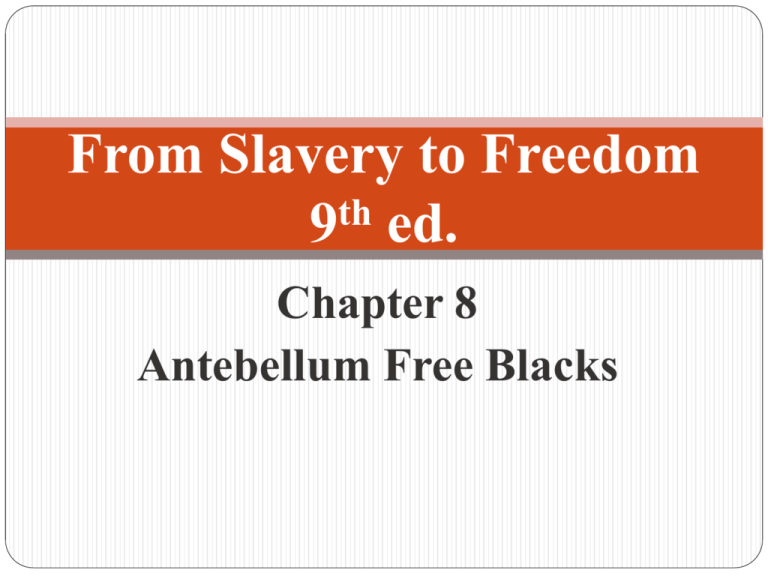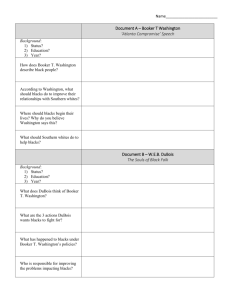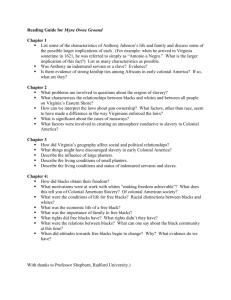
From Slavery to Freedom
th
9 ed.
Chapter 8
Antebellum Free Blacks
Freedom’s Boundaries
Black Laws
Missouri Compromise part of larger debate
within individual states about civil status of free
blacks
Many states passed laws barring in-migration of
free blacks
Fear that free blacks would threaten slavery; desire to
limit black population
2
© 2010 The McGraw-Hill Companies, Inc. All Rights Reserved.
Freedom’s Boundaries
Migration West
Alexis de Tocqueville – paradox of racial
intolerance in states where slavery never existed
Despite laws and cultural hostility, free black
population grew dramatically in the Midwest
Blacks continued to head west in search of
economic opportunity
Disfranchisement
Free blacks’ political rights declined everywhere
Pennsylvania revised constitution to disfranchise
3
© 2010 The McGraw-Hill Companies, Inc. All Rights Reserved.
Freedom’s Boundaries
By end of Antebellum period, only New England
states gave black men unrestricted right of
suffrage
Demographics
Black population continued to grow, but relative
to the entire U.S. population the percentage of
free blacks began to decline
Increasingly rigid manumission laws
Significant increase in European immigrants
4
© 2010 The McGraw-Hill Companies, Inc. All Rights Reserved.
In a Culture of Racism
Minstrel Shows
Blackface white actor performed caricatured
images, dialect speech, and song
Promoted stereotypical images like “Jim Crow”
Ethnology
Professed methods and theories that stressed
innate and immutable racial traits
Craniology – blacks have smaller skull size, thus lower
intelligence
Polygenesis – races emerged from different human
origins and are therefore different human species
5
© 2010 The McGraw-Hill Companies, Inc. All Rights Reserved.
In a Culture of Racism
Bigotry and Prejudice
Word nigger began to be used as a term of racial
disparagement
Collective acts of animosity directed at free
blacks became common
Mob Violence
Free blacks scapegoated for diminished
economic prospects of white workers
Riots, murders, and destruction of churches, schools,
and orphanages occurred in Midwest and Northeast
6
© 2010 The McGraw-Hill Companies, Inc. All Rights Reserved.
In a Culture of Racism
South vs. North
Blacks mistreated in North and West to delight of
southern slaveholders who enjoyed playing up
northern hostility
In the North, however, blacks could agitate and
organize for their rights; could enter professions and
jobs barred from them in the South
Southern freedom tenuous
Slip could send back to slavery
Controls over free blacks continued to increase
Prohibition on in-migration; re-enslavement laws
7
© 2010 The McGraw-Hill Companies, Inc. All Rights Reserved.
Economic and Social Life
Trades and Professions
Restrictions on employment; but free blacks
were required to work
Skilled and unskilled blacks found employment
in areas experiencing labor shortages
Lower South had largest proportion of free black
and skilled positions
8
© 2010 The McGraw-Hill Companies, Inc. All Rights Reserved.
Economic and Social Life
Property Ownership
Regional differences in property ownership
Property “owned” by southern blacks included
enslaved family members
9
© 2010 The McGraw-Hill Companies, Inc. All Rights Reserved.
African American barber
10
© 2010 The McGraw-Hill Companies, Inc. All Rights Reserved.
Economic and Social Life
Urban Life in the North
Northern Antebellum blacks more likely than
whites to live in cities
Boston
Smallest free black community of northern
seaport cities
Residential segregation created geographical
concentration of the black community
Certain positions, like porter, held higher prestige
Upper class and middle class were strong in tradition
of protest thought
11
© 2010 The McGraw-Hill Companies, Inc. All Rights Reserved.
Economic and Social Life
New York
More affluent than black Bostonians
Clearly demarcated economic and cultural
differences among blacks
Many opportunities for interracial mixing among
lower classes
Philadelphia
Distinct three-tiered class structure among free
blacks
Active in temperance crusade
12
© 2010 The McGraw-Hill Companies, Inc. All Rights Reserved.
Economic and Social Life
Mutual Aid Organizations
Free blacks formed organizations to bind
themselves together socially and culturally
Outlawed in many southern states
Cultural Contributions
Free black poets, playwrights, historians,
newspaper editors, and artists contributed to
development of African American culture
George Moses Horton; Daniel Alexander Paine;
Harriet E. Wilson; Robert S. Duncanson
13
© 2010 The McGraw-Hill Companies, Inc. All Rights Reserved.
Education
Opportunities in the North
By eve of Civil War, educational opportunities
widely available for black education in North
Educational opportunities varied widely among
states and communities
In 1855, Massachusetts legislature prohibited
segregated schools
Opportunities in the South
Harder for southern free blacks to get education
No public schools, even for white children
Public sentiment against free black education
14
© 2010 The McGraw-Hill Companies, Inc. All Rights Reserved.
Education
Higher Education
Northern free blacks began to attend institutions
of higher education during antebellum period
Some schools that became predominantly black
institutions opened during this time
15
© 2010 The McGraw-Hill Companies, Inc. All Rights Reserved.
Black Convention Movement
Black Convention Movement
Black delegates met to “devise ways and means
for the bettering of our condition”
The Rochester Convention
Over 100 people gathered and formed the
National Council of Colored People
Sought to advance equal rights and end slavery
Fostering Group Consciousness
Conventions way to promote collective
discussion and action
16
© 2010 The McGraw-Hill Companies, Inc. All Rights Reserved.
Black Convention Movement
Public Image and Behavior
Debated name that identified them as a people
and a race
Leaders emphasized group and individual
behavior – stressing temperance, church
attendance, and thrift
Biblical Imagery
Used religious imagery in addressing issues
Drew repeatedly on Exodus
17
© 2010 The McGraw-Hill Companies, Inc. All Rights Reserved.
Black Women
Women Take Public Action
Free black women attempt to bring gender
inequality into discussion on racial inequality
Free black women enlisted in public movements for
black freedom
Jarena Lee
Maria Stewart
One of earliest and most outspoken advocates of
women’s rights and abolition
Considered the first black feminist
18
© 2010 The McGraw-Hill Companies, Inc. All Rights Reserved.
Portrait of Jarena Lee
19
© 2010 The McGraw-Hill Companies, Inc. All Rights Reserved.
Black Women
Sojourner Truth
Best known black women in women’s rights and
abolitionist movements
Exposed the socially constructed character of
gender
20
© 2010 The McGraw-Hill Companies, Inc. All Rights Reserved.
The Debate on Emigration
Efforts at Mass Colonization
Despite schemes to deport free blacks, no more
than 15,000 migrated outside U.S.
The American Colonization Society (ACS) responsible
for transporting most
Mass colonization proved unworkable
Not economically feasible
Could not agree on single program because of varying
motives of ACS members
21
© 2010 The McGraw-Hill Companies, Inc. All Rights Reserved.
The Debate on Emigration
Opposition to the ACS
Opposition grew steadily among black and white
abolitionists, although recurring discussions of
emigration continued at conventions into the
1850s
Emigration supporters like H. Ford Douglas,
James Theodore Holly, and Martin R. Delany
distanced themselves from the ACS
22
© 2010 The McGraw-Hill Companies, Inc. All Rights Reserved.
Map of Monrovia, Liberia, ca 1830
23
© 2010 The McGraw-Hill Companies, Inc. All Rights Reserved.
The Debate on Emigration
The National Emigration Convention
Promoted black-led emigration movement
Douglas, Holly, and Delany vocal supporters
Factionalism over whether Canada, Africa, or
Haiti was best place to emigrate to
Mary Ann Shadd Cary was strongest female
emigrationist voice
24
© 2010 The McGraw-Hill Companies, Inc. All Rights Reserved.








